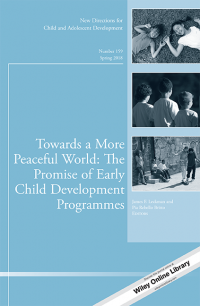The refugee crisis & the rights of children: Perspectives on community‐based resettlement programs
Introduction
The global community is currently facing one of the largest and most complex refugee crises in modern times. Conflict and natural disasters have resulted in 22.5 million refugees worldwide, more than half are children. As the world struggles to respond to this massive displacement of people, how is this affecting child refugees’ development and what is being done about it? the commentary “The refugee crisis and the rights of children: Perspectives on community‐based resettlement programs” in the Spring 2018 special issue of New Directions in Child and Adolescent Development (NDCAD), explores answers to these central questions.
-
First, reviewed is the situation of child refugees in numbers, exploring their geographic concentration.
-
Second, reviewed is child refugees’ access to basic services, including early childhood development, with a special emphasis on community‐based programs and initiatives that have proven to be particularly effective in addressing the needs of resettled child refugees.
Findings show that early childhood development activities in emergency contexts have seen remarkable improvements with critical benefits for the development of the youngest child refugees. The aim is to bring attention to the particular difficulties child refugees must endure and to highlight those practices and approaches that are helping child refugees reach their full potential.
Video (Eng) | Dr. Nicholas Alipui: The UN’s 2030 Agenda for Sustainable Development in Regard to Child Rights (30:37)
By Nicholas Alipui Nicole Gerke (2018)
We are currently facing one of the largest and most complex refugee crises in modern times. Our aim is to bring attention to the particular difficulties child refugees must endure and to highlight those practices and approaches that are helping child refugees reach their full potential.
JOIN THE CONVERSATION
For breaking news and to stay connected, follow us on social media. Sign up to get our E-News delivered straight to your inbox.



